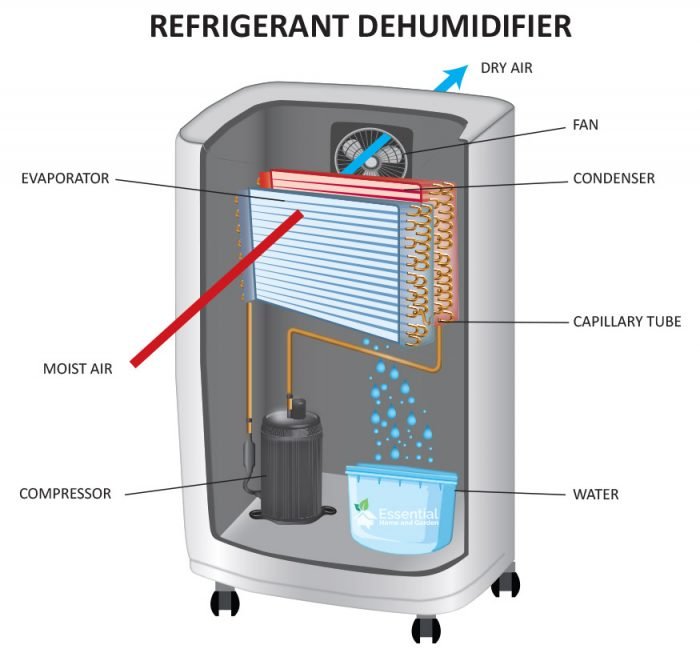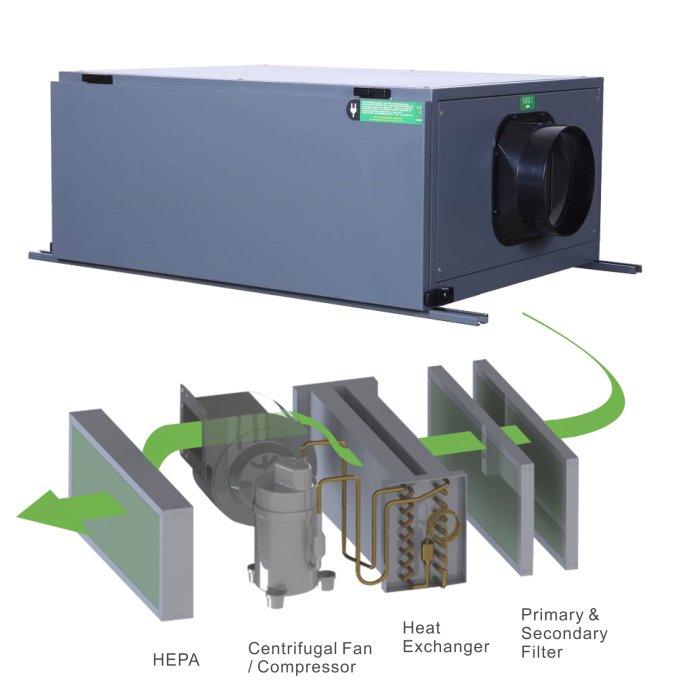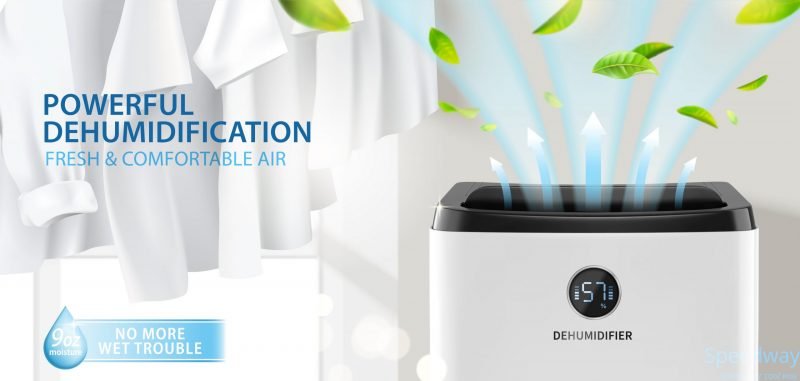Humidity can bring lots of inconvenience for people’s daily lives, and dehumidifier is one kind of equipment to reduce the level of humidity, many people use them at home, especially in hot and humid areas.
Following we want to give you some knowledges about humidity and dehumidifier.
Dangers Of Humid Environment
1. Uncomfortable for Human Being
Normally, many people feel uncomfortable with heavy humidity, because that is beyond the comfortable range.
In general, people feel more comfortable when the relative humidity (short called RH) of the environment they live in is between 40% and 60%.
Whether people are comfortable with humidity level is also related to temperature
For example, at a lower temperature of 18℃~23℃, the relative humidity is slightly higher and more comfortable, such as 60%; while at a higher temperature of 23℃~28℃, the relative humidity is slightly lower and more comfortable, such as 40%.
2. Joint Pain
If a person lives in a humid environment for a long time, the balance of the body’s internal environment will be imbalanced, and the secretion of inflammatory cytokines will increase, causing an inflammatory response that can lead to rheumatoid arthritis.
Joint pain
In addition, for people who already suffered from rheumatoid arthritis, the changeable temperature combined with high humidity in the air can easily lead to aggravation or worsening of rheumatoid arthritis, as well as pain or infection in the back strain, sprains, fractures, and surgical incisions and other parts of the adjacent joints.
3. Mold Infection
A warm and humid environment is conducive to mold growth and reproduction, long-term stay in the humid environment, mold is very easy to spread in the toes and other parts, causing skin tinea disease, not timely treatment will also hurt other parts of the body.
Room in a humid environment for a long time will produce a moldy smell, which is likely to cause some pathological changes in the respiratory tract and lungs if the human body often breathes this smell.
4. Allergic Reaction
In fact, high humidity is the core cause of various allergic diseases in children.
According to research, if the room is too wet, the number of dust mites will increase, and children are more likely to have allergic reactions to dust mites in damp rooms.
5. Affect Sleep
In the sleep state, human body’s resistance is relatively weak, and the wet sleep environment is prone to insomnia and dreaminess, which leads to malaise and listlessness.
6. Clothes Are Prone To Mildew
If the indoor environment is damp, clothes are easy to get moldy, space will fill with a mildew smell, and clothes are not easy to dry after cleaning or even mildew before drying.
Food is also prone to mildew, if you accidentally eat moldy food, light to be diarrhea, will endanger life for serious situations.
Dehumidifier Classification And Working Principle
1. Refrigerant Dehumidifier
Refrigerant dehumidifier mainly consists of a compressor, heat exchanger, fan, water tank, casing, and controller, etc. The humid air is pumped into machine by the fan, passed through the heat exchanger. Meantime the air condenses into water droplets and becomes dry air, then discharged from the machine.
Working principle: In normal operation, the evaporator absorbs heat from the outside. Under the action of the fan, wet air is drawn in from the air inlet, and heat exchange is carried out through the evaporator, thus its temperature is reduced; when the wet air reaches the dew point temperature, moisture is precipitated due to condensation, meanwhile, the absolute moisture content of wet air reduce.
Heat exchange happens again through the condenser when the temperature rises, so as to achieve the purpose of heat preservation and dehumidification.
2. Ceiling Mounted Dehumidifier
A kind of dehumidifier installed on the wall or ceiling. The best features are small size, easy installation, doesn’t occupy room space, doesn’t affect the effect of indoor decoration, to achieve hidden dehumidification.
It can be divided into:
2.1) Freezing Ceiling Dehumidifier
its dehumidification principle is the same as the vertical freezing dehumidifier principle: Water vapor is condensed into water, so as to exclude outdoor.
It has a good dehumidification effect above the normal room temperature (25℃), which performs very fast, so it is suitable for summer use. However, in low temperatures, especially below 10 ℃, its dehumidification effect is very poor, because the dehumidifier heat exchange system will frost, to stop the compressor from working, and then the evaporator began to defrost. In the process of defrosting the dehumidifier is in a non-working state.
Therefore, if you want to dehumidify in the low-temperature state as well, then the frozen ceiling dehumidifier will not apply.
2.2) Central Fresh Air Ceiling Dehumidifier
Working principle: Filter the outdoor air after dehumidification, use the fresh air ducts send the set relative humidity air to the indoor, in order to comfort or environmental humidity demand.
The fresh air ceiling dehumidifier operates with low noise and can provide low-speed air volume to ensure the continuity of the dehumidifier’s operation.
2.3) Rotor Ceiling Dehumidifier
Also called desiccant rotor ceiling dehumidifier, desiccant dehumidifier normally is used for industrial purpose, but also have type for home use.
Rotor Ceiling Dehumidifier Structure
Working principle: Use the rotor containing adsorbent material to absorb moisture in the humid air on the silica gel rotor, and then to the regeneration area of the rotor, the water adsorbed in the silica gel rotor will be heated and vaporized to the entrance of heat exchanger, forming high temperature and high humidity air, followed by the heat exchanger that has been cooled by the cold humid indoor air (due to the different dew point and condensed water discharge).
Its advantage is: not affected by the temperature and can operate normally at low temperatures, but the disadvantage is: use a high-quality silicone rotor, which costs higher than the refrigerated dehumidifier.
3. Semiconductor Dehumidifier
It is a type of dehumidifier for dehumidification through semiconductor refrigeration, which is generally only suitable for small spaces, such as wardrobes, cabinets, shoe cabinets and bathrooms.
If the space is too large, the dehumidification effect will be much worse.
Generally, recommend using space within 20 square meters.
Working principle: When the treated air with larger moisture content flows through the evaporator when the temperature decreases, part of the water vapor in the air condenses on the surface of the evaporator and precipitates into water droplets. In the lower part of the evaporator with water collection plate, the condensate will be collected and flowed into the water storage container and discharged to the outdoors.
Note: Semiconductor dehumidifiers have been selling well due to their low price and lightweight equipment. Its dehumidification effect is not as good as ordinary dehumidifiers, but the dehumidification effect for small spaces is still very good. Because it uses semiconductor components to control the performance of the dehumidifier, no compressor, the dehumidification effect is far lower than the refrigerant type dehumidifier. You must consider your home humidity level. For the heavy humid area, semiconductor dehumidifier is not a good choice.
Semiconductor Dehumidifier
3.1) Advantages
Low production cost:
the core component is a semiconductor refrigeration system, which is relatively low in cost.
Low use cost:
Low power consumption, which is only 1/5-1/10 of the power consumption of the compressor dehumidifier.
Simple structure, low failure rate, and long service life.
Small size:
easy to use in small spaces, especially in moldy wardrobes, cabinets, bathrooms, lockers, etc.
Light weight:
easy to move, easy to use in different places.
No mechanical vibration, low noise, can be used in the bedroom.
3.2) Disadvantages
Due to the limited refrigeration capacity of semiconductor refrigeration systems, its dehumidification capacity is relatively poor, so it is not suitable for large area space.
Can Air Conditioning Dehumidification Replace Dehumidifiers?
Of course NOT, reasons:
1. Dehumidifiers do not lower room temperature
In general, air conditioning dehumidification requires continuous cooling in order to achieve the effect of dehumidification, the lower the temperature, the better the dehumidification effect.
This will cause more dehumidification, the colder and colder, the experience is very bad.
Although some professional factories already can produce a constant temperature dehumidification air conditioner, but its price is much higher, and the effect is worse than dehumidifier.
2. Dehumidifiers’ power consumption is low
For a normal air conditioner in working mode, plus dehumidification, power consumption is much larger.
Dehumidifier is only about one-fifth of the power consumption of air conditioner, definitely no reason to replace.
3. Dehumidifiers are better for mobility
Dehumidifiers can move around when in operation. But air conditioners can’t move around. Although portable air conditioner can be movable, need to disassemble and reinstall, and the movement is very limited (need to be installed to the window).
4. Dehumidifiers can monitor humidity in real-time
Air conditioners usually do not have humidity sensors, require other equipment to assist real-time monitoring.
How to Save The Power Consumption?
Dehumidifier power consumption depends on its power, a small home dehumidifier is about 220w, and the large home dehumidifier is about 550w, smaller than the power of wall split air conditioner a lot.
If you want to save electricity, please pay attention to the following:
1. Adjust the humidity too low is ineffective, the air is still very humid
If the setting temperature is too low, the room won’t only be too dry, but also will reduce the lifespan of the dehumidifier.
2. Located correctly
Don’t tilt or install in the non-ventilated place, dehumidifier (had better located at the center of room) inlet and outlet should be kept unblocked, in order to discharge the moisture from the whole room.
3. Close the window
Close the window when using dehumidifier, otherwise the outdoor moisture will enter the room again. Occasionally you can open the window, but do not open it when heavily humid outside, especially on rainy days.
Tips: For the small room, we recommend using the traditional compressor type (Refrigerant dehumidifier), the dehumidification range can meet the requirements of low power consumption. On the contrary, if the room size is large, better to use the rotor type, which consumes a lot of electricity but can achieve the desired dehumidification effect.
Dehumidifier Selection Checklist
1. According to the room area
Such as 100 square meters INDOOR AREA (not a duplex), you can buy one piece, for a duplex or villa, we recommended choosing 2-3pcs dehumidifiers (each floor one piece).
2. According to the actual use of the place
For the largest space such as a living room or bedroom is more than 40 square meters, you can choose the dehumidification capacity of 40L/24hrs or more. for 30-40 square meters of space, you should choose the dehumidification capacity of 20-30L/24hrs or more, and so on.
3. House basement
Need to be calculated according to the basement space area, if stored lots of items, for example, the basement is 20 square meters, we should buy a dehumidification capacity of 30L/24hrs home dehumidifier, because also need to dehumidify stored items.
Noise Level
Noise is the more concerning point for most household appliances, especially at night’s rest, after all, if you get a good night’s sleep, your health will be better.
So if the dehumidifier is placed in the bedroom to use, it is best to choose a unit less than 40 dB(A). Of course, you can also dehumidify before sleep.
Actually, certain dehumidifier manufacturers find some ways to reduce noises of the machine itself, like using a DC motor, thinner fan blade, etc, which can fundamentally reduce noise, no matter where you use it.
Dehumidifier Cleaning
Household dehumidifier filters need to clean once every two weeks, with clear water below 40 ℃ to clean, not only can keep the cleanliness of the filter, but also prevent the accumulation of dust in the dehumidifier; meanwhile, avoid dust condensation in the condenser foil, also can purify the air in the room.
Dehumidifier Washable Filter
After Usage
If the dehumidifier is not used for a long time, you should use a special shield to protect the dehumidifier to prevent dust from falling into the machine inside, which will increase the difficulty of cleaning and maintenance in the future.
If the environment allows, should store the dehumidifier in a relatively dry environment, so as to avoid the dehumidifier circuit moisture short circuit, to ensure the normal use of the dehumidifier computer motherboard.
Special Use of Dehumidifier
Now even the dehumidifier can dry clothes? Can you imagine?
Dehumidifier to dry clothes
Just three steps, the dehumidifier is easy to dry clothes!
First step:
Take the clothes (need to be dried) into the room, and hang them on the shelves, preferably 80-90 cm above the ground.
Second step:
Place the dehumidifier under or in front of the clothes, point the air outlet toward the clothes that are hanging, and adjust the desired room and dryness of the clothes on the dehumidifier.
Third step:
Give the clothes to the dehumidifier and wait for them to become dry!
Conclusion
Well, have you got some knowledge about Dehumidifier? We believe you will be the one who knows dehumidifiers best around you. Go and show them.
Any comments?
Welcome leave a message or repost.


















2 Responses
This is verʏ interesting, You’re a ᴠery skilled blogger.
I have joined your fеed and look forward to seeking
more of your fantastic ρost. Also, I’ve shared your website in my
social networks!
Thank you so much for your kindness. Please let more people know about our blogs, appreciated it.